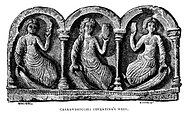Maponos
| Part of a series on |
| Celtic mythologies |
|---|
 |
In
The Welsh mythological figure Mabon ap Modron is apparently derived from Maponos,[1] who by analogy we may suggest was the son of the mother-goddess Dea Matrona. The Irish god Aengus, also known as the Mac Óg ("young son"), is probably related to Maponos, as are the Arthurian characters Mabuz and Mabonagrain.
Etymology
In
In
He therefore personified youthfulness, which would explain the syncretism with the Graeco-Roman god Apollo.
Evidence for Maponos
Epigraphy
The evidence is mainly epigraphic. Maponos (“Great Son”) is mentioned in
Deo / Mapono / et n(umini) Aug(usti) / Durio / et Ramio / et Trupo / et Lurio / Germa/ni v(otum) s(olverunt) l(ibentes) m(erito)
willingly, as is deserved."
"To the god Maponos and to the
This inscription (RIB 583) by a unit of
- Deo san(cto) / [A]pollini Mapono / [pr]o salute d(omini) n(ostri) / [et] n(umeri) eq(uitum) Sar/[m(atarum)] Bremetenn(acensium) / [G]ordiani / [A]el(ius) Antoni/nus |(centurio) leg(ionis) VI / vic(tricis) domo / Melitenis / praep(ositus) et pr(aefectus) / v(otum) s(olvit) l(ibens) m(erito) / [de]dic(atum) pr(idie) Kal(endas) Sep(tembres) / [Im]p(eratore) d(omino) n(ostro) Gord[i]/[ano A]ug(usto) II e[t] Pon[peia]no(!) co(n)s(ulibus)
The preceding inscriptions are all in Latin. The name is also found on the inscription from Chamalières, which is a relatively long magical text (12 lines) written in
Iconography
There are at least three statues to Maponos. In one, he is depicted as a harper and stands opposite a Celtic Diana huntress figure. A sketch of this image appears in Ann Ross' Pagan Celtic Britain.[4]
Toponymy
Two items of place-name evidence also attest to Maponos in Britain. Both are from the 7th-century
Coligny Calendar
The fifteenth day of Riuros on the Coligny calendar is marked with the name Mapanos, which might be a reference to a festival for Maponos.[4]
Celtic epithets of Apollo
In Britain, dedications to Apollo have been found with the following epithets:
- Apollo Anextiomarus
- Apollo Anicetus Sol
- Apollo Grannus
- Apollo Maponus (shows a Latinising influence, -os becoming -us).
It can thus be difficult to tell from a simple dedication to Apollo whether the classical deity is meant or whether a particular Celtic deity is being referred to under a classical name. The situation in Gaul is even more complicated, with at least twenty epithets being recorded. (Jufer & Luginbühl pp. 94–96).
Later tradition
Welsh mythology
Maponos surfaces in the
His name lives on in
.Irish mythology
His counterpart in
See also
References
- ^ ISBN 9781851094400.
- ^ Matasović, Ranko. Etymological Dictionary of Proto-Celtic, page 253. 2009. Brill.
- ^ CIL VII 1345 = RIB 1, 1120: Apollini/ Mapono/ Q(uintus) Terentius/ Q(uinti) f(ilius) Ouf(entina)/ Firmus Saen(a)/ praef(ectus) castr(orum)/ leg(ionis) VI v(ictricis) p(iae) f(idelis)/ d(onum) d(edit)
- ^ a b Jones, Mary. "Apollo Maponos". Jones's Celtic Encyclopedia. Retrieved 4 August 2019.
Bibliography
- Année Epigraphique (AE), yearly volumes.
- Corpus Inscriptionum Latinarum (CIL); vol. XIII, Inscriptiones trium Galliarum et Germaniarum
- Collingwood, R. G.; Wright, R. P. The Roman Inscriptions of Britain (RIB) Vol. 1: The Inscriptions on Stone.
- Delamarre, X. (2003). Dictionnaire de la Langue Gauloise (2nd ed.). Paris: Editions Errance. ISBN 2-87772-237-6
- ISBN 0-19-508961-8
- Hamp, E. (1999) "Mabinogi and Archaism". Celtica 23, pp. 96–110. Available online PDF file
- Jufer, N. and Luginbühl, T. (2001) Répertoire des dieux gaulois. Paris, Editions Errance. ISBN 2-87772-200-7
- Lambert, Pierre-Yves (1979) "La tablette gauloise de Chamalières". Études Celtiques XVI pp. 141–169
- Lambert, Pierre-Yves (ed)(2002) Recueil des Inscriptions Gauloises (R.I.G.) Vol. 2.2: inscriptions in the Latin alphabet on instrumentum (ceramic, lead, glass etc.) (items L-18 – L-139)
- MacKillop, James (1998) Dictionary of Celtic Mythology. Oxford: Oxford University Press. ISBN 0-19-280120-1.
- Meid, W. (1991) Aspekte der germanischen und keltischen Religion im Zeugnis der Sprache. (Innsbrucker Beiträge zur Sprachwissenschaft, Vorträge und kleinere Schriften, 52.)
- Richmond, I. A. and Crawford, O. G. S. (1949) "The British Section of the Ravenna Cosmography". Archaeologia XCIII pp. 1–50
- Sims-Williams, Patrick (2003) The Celtic Inscriptions of Britain: phonology and chronology, c. 400-1200 Oxford: Blackwell. ISBN 1-4051-0903-3
- Wood, Juliette, (2002) The Celts: Life, Myth, and Art. Thorsons Publishers. ISBN 0-00-764059-5
External links
 Media related to Maponos at Wikimedia Commons
Media related to Maponos at Wikimedia Commons- Locus Maponi
- Maporitum


